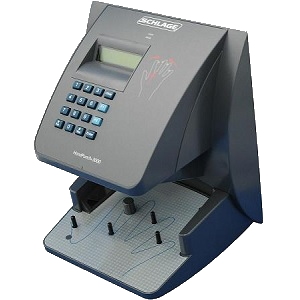HandPunch Models
The Time and Attendance software supports the models HP1000 thru HP4000. This includes the E models (Ethernet) and the XL models (break compliant).
Communication Options
RS-232
All models can communicate with RS-232 communications. This is a 3-wire communication: Receive, Transmit and Ground. There is a physical limit to the length of the cable that should be used. A maximum length of 50 feet is recommended. The current RS-232 cable supplied with the HP1000 and HP2000 models has a DB9 connector at the computer end and a three pin terminal block at the HandPunch.
Older models used an RJ45 ribbon cable, with a DB9 to RJ45 converter at the computer.
Out of the box, both the HP1000 and HP2000 models will communicate via RS-232 cable. The HP3000 and HP4000 models do not have the RS-232 communications turned on by default.
RS-485
The HP3000 and HP4000 models can communicate with RS-485/RS-422 communications. The terms RS485 and RS422 tend to be used interchangeably, although there are some differences. This communication protocol allows a cable run up to 5000 feet in length, with up to 31 HandPunches connected. The wire used is very important and is typically a 22 gauge, 4 wire, fully shielded cable.
An RS-232 to RS-485 converter converts from the computer’s serial port (RS-232) to the RS-485 protocol.
The RS-485 side of the converter will provide Receive +, Receive -, Transmit +, and Transmit -. At each HandPunch, a data jack converts from the 4 wires to an RJ12 connector. The wiring at each HandPunch is identical. A 4-wire RJ12 data cable goes from the data jack to the RJ12 connector in the HandPunch.
At the converter, the wiring is such that the Receive on the converter matches with the Transmit on the HandPunch, i.e. R- to T-.
In a HandPunch, the pins in the RJ12 connector from left to right are: 1 = R+, 2 = R-, 3 = T- and 4 = T+.
On older HandPunch models with dip switches, only the HandPunch at the end of the wire run should have the dip switches numbered 1 and 2 in the on position.
Modem
A phone line is connected to the internal modem on each HandPunch. The computer uses a modem to dial out and connect to each HandPunch. The HandPunch modem is a 14,400 bps modem but is used at 2,400bps.
Ethernet
The HandPunch supports both an internal and external Ethernet adapter. An external Ethernet adapter will typically provide remote administration. The internal adapter requires you to set the network information at the HandPunch.
Ethernet is the recommended method of communication for many reasons:
- The communication can be performed from the server, or from any computer.
- You do not need to connect the HandPunch directly to the server.
- You avoid all issues dealing with failed com ports and/or phone line issues.
- You use your existing network infrastructure to provide communication, including a WAN, VPN or internet connection with port forwarding.
